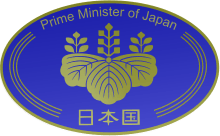Government Seal of Japan


The Government Seal of Japan, one of the national seals, is an emblem (mon) of paulownia used by the Cabinet and the Government of Japan on official documents. It is one of various paulownia mon, collectively known as the Paulownia Seals (桐紋 kirimon) or the Paulownia Flower Seals (桐花紋 tōkamon).[1][2]
The 5-7 Paulownia (五七桐 go-shichi (no) kiri) is used as the official emblem of the Prime Minister of Japan. It resembles a stylized paulownia with 5-7-5 flowers.
Before the Chrysanthemum Seal was used extensively, the Paulownia Seal originally was the private symbol of the Japanese Imperial Family, from as early as the twelfth century. The Toyotomi clan, led by Toyotomi Hideyoshi, later adopted the Paulownia Seal for use as the crest of his clan. After the Meiji Restoration, the seal was eventually adopted as the emblem of the Japanese government.[3][4]
It is now still mainly used by the Japanese government, as a contrast to the Chrysanthemum Seal which represents the Emperor as the symbol of the sovereignty of the State, and members of the Imperial Family.
Designs
More than 140 designs exist. The most common one is the 5-3 Paulownia (五三桐 go-san kiri), consisting of three leaves and an inflorescence of 3-5-3 flowers.[1][2] It is found in the emblem of the Ministry of Justice and the Imperial Guard Headquarters. According to a study by Nihon Kamon Kenkyukai (Japan Kamon Society), about 70% of the paulownia crests use "Maru ni go-san kiri" (丸に五三桐), a roundel of the 5-3 Paulownia.
The 5-7 Paulownia (五七桐 go-shichi (no) kiri) has been used by those in power and is the official emblem of the Prime Minister of Japan today.
5-3 Paulownia
|
5-7 Paulownia
|
Other
|
See also
References
- 1 2 Amimoto, Mitsuyoshi (25 August 2011). Ketteiban Shire ba Shiru hodo Omoshiroi! Kamon to Myoji. Tokyo, Japan: Seitosha. pp. 174–175. ISBN 978-4-7916-1821-7. Retrieved 11 June 2015.
- 1 2 Takasawa, Hitoshi (1 September 2011). Irasuto Zukai Kamon (First ed.). Tokyo, Japan: Nitto Shoin Honsha. pp. 59–61. ISBN 978-4-528-01934-8. Retrieved 11 June 2015.
- ↑ Griffis, William Elliot (1876). "Sūjin, the Civilizer". The Mikado's Empire. New York, United States: Harper & Brothers. p. 67. Retrieved 2010-01-17.
- ↑ Dalby, Liza (2007). "Paulownia Blooms". East Wind Melts the Ice: A Memoir Through the Seasons. California, United States: University of California Press. p. 51. Retrieved 2010-01-17.
External links
- Kamon Database by KamonDB: Kirimon (Japanese)
- Kamon Database by Studio Hata: Kirimon (Japanese)




.svg.png)


